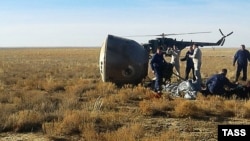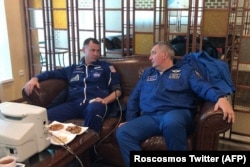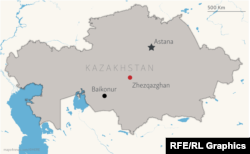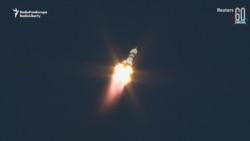A space capsule carrying a two-man Russian-American crew that malfunctioned after liftoff has landed safely in the steppes of central Kazakhstan, the Russian and U.S. space agencies say.
Russian cosmonaut Aleksei Ovchinin and U.S. astronaut Nick Hague returned to Earth on October 11 in their Soyuz capsule for an emergency landing following a problem with the booster rocket shortly after a launch bound for the International Space Station (ISS).
Both NASA, the U.S. space agency, and Roskosmos, the Russian equivalent, said the astronauts were in good condition after their capsule landed about 20 kilometers east of the Kazakh city of Zhezqazghan.
“Search and rescue teams were deployed to the landing site," NASA said in a statement. "Hague and Ovchinin are out of the capsule and are reported to be in good condition. They will be transported to the Gagarin Cosmonaut Training Center in Star City, Russia outside of Moscow."
Russia said it was suspending manned flights, and announced the launching of an investigation into what went wrong.
"A team of investigators is currently looking at the launching site and it has seized documents. Investigators aim to establish the causes of the incident and who is responsible for it," Russia's Investigative Committee said in a statement on October 11.
"The cosmonauts are alive. They have landed. They have been found," according to a source at the Russia-leased Baikonur launch facility in Kazakhstan.
The crew had to return in "ballistic descent mode," NASA earlier had said, which it explained was "a sharper angle of landing compared to normal."
Following their emergency landing, NASA published pictures of Hague and Ovchinin undergoing a medical checkup and relaxing on sofas in Zhezqazghan. The two were expected to be flown to Baikonur and then on to the Gagarin Cosmonaut Training Center outside Moscow.
Roskosmos chief Dmitry Rogozin said he had ordered a state commission to be set up to investigate the causes of the malfunction, while Russian Deputy Prime Minister Yuri Borisov announced that manned space flights would be suspended until the probe is completed.
The Soyuz capsule automatically jettisoned from the booster when it failed 123 seconds after the launch from Baikonur, Borisov said, according to the Interfax news agency.
The minister added that the problem occurred when the first and second stages of the booster rocket were in the process of separating.
Footage from inside the spacecraft showed the crew being shaken around at the moment the failure occurred.
In a statement, NASA administrator Jim Bridenstine said that a "thorough investigation into the cause of the incident will be conducted."
Hague and Ovchinin were due to spend six months on the ISS, which is orbiting 400 kilometers above the Earth.
Relations between Moscow and Washington have plunged to the lowest level since the end of the Cold War over the wars in Ukraine and Syria, allegations of Russian meddling in the 2016 U.S. presidential, and other issues, but Russia and the United States have maintained cooperation in space.
PHOTO GALLERY: Soyuz Crew Returns To Earth After Aborted Mission (CLICK TO VIEW)
The Russian-built Soyuz spacecraft is currently the only vehicle for ferrying crews to the ISS following the retirement of the U.S. space shuttle fleet in 2011.
The October 11 booster failure led to what is said to be the first emergency landing for the Soyuz since 1975, when it failed to separate between stages during an ascent and triggered the abort system. The crew survived.
In 1983, a Soyuz exploded on the launchpad soon after the two cosmonauts it was carrying jettisoned. The crew also survived without injuries.

















